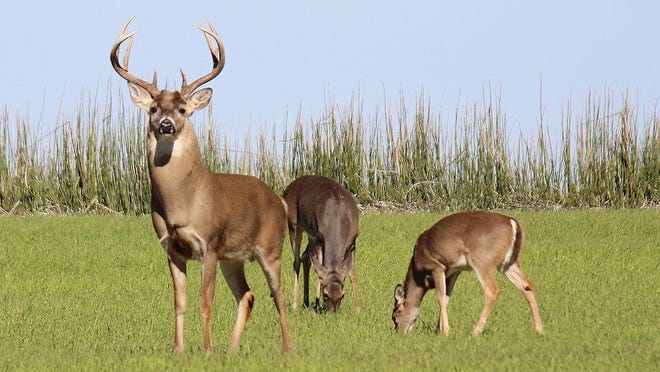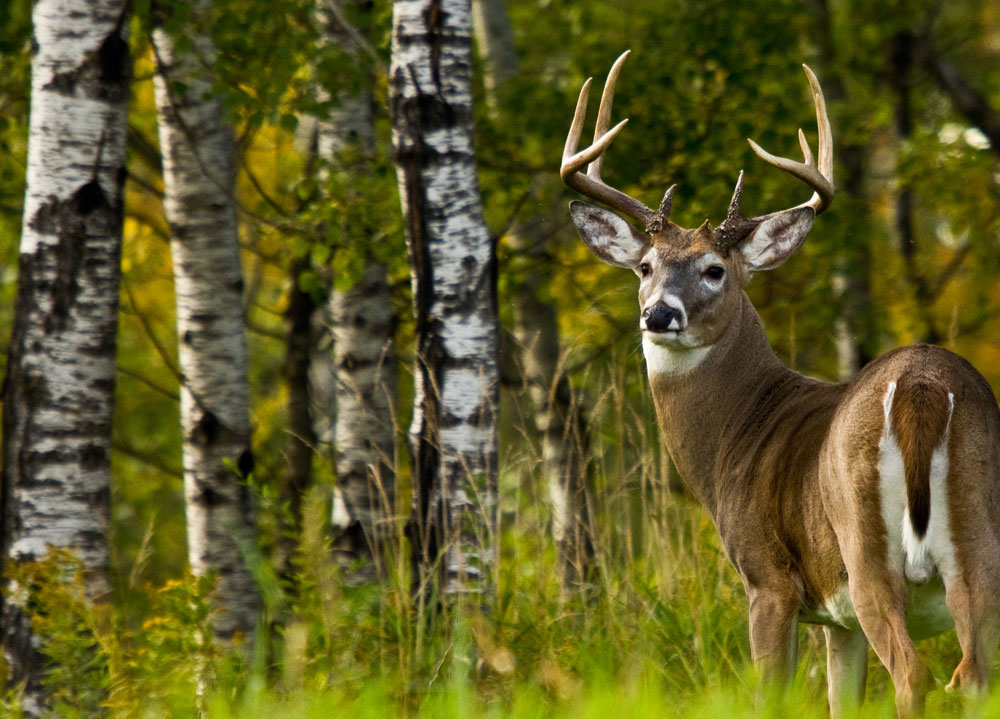Whitetail deer are attracted to various types of food sources such as acorns, fruits, vegetables, and nuts. Some of their favorite foods include apples, corn, soybeans, alfalfa, and clovers.
As a hunter or wildlife enthusiast, knowing what whitetail deer are attracted to can significantly increase your chances of attracting and observing them. Deer are magnificent creatures that feed primarily on vegetation, so selecting the right type of food sources is critical. Whitetail deer are attracted to certain scents, some which are natural in the environment, while others may be artificially introduced. In addition to food sources, whitetail deer are attracted to water sources, making it important to locate waterways and watering holes in their habitat. Knowing what whitetail deer find attractive can give you an edge in hunting or simply observing them in the wild.

Credit: www.cjonline.com
Contents
- 1 Understanding Whitetail Deer
- 2 What Attracts Whitetail Deer
- 3 How To Attract Deer To Your Property IN 3 EASY STEPS!
- 4 Luring Whitetail Deer With Scents
- 5 Setting Up The Perfect Deer Feeding Station
- 6 Deer Hunting Tips And Precautions
- 7 Frequently Asked Questions On What Are Whitetail Deer Attracted To?
- 8 Conclusion
Understanding Whitetail Deer
Whitetail deer are one of the most common type of deer in north america. Understanding them and their habitats is important for any wildlife enthusiast. These majestic creatures can be found in a variety of habitats, from forests to fields, and even suburban areas.
Typically they are attracted to areas with plenty of vegetation such as shrubs, grasses, and trees which provide them with both food and shelter. Whitetail deer are herbivores and feed primarily on plants and fruits, making them a vital component of many ecosystems.
It is important to appreciate these beautiful creatures and to take measures to help preserve their habitats and populations for years to come.
What Attracts Whitetail Deer
Whitetail deer are selective grazers that prefer natural food sources like shrubs, trees, and grass. They love fruits, acorns, and berries when in season. Study the area to know the plant species preferred by these gentle creatures. Some food sources are scarce during different seasons, and you must have alternative feeds, such as corn, alfalfa, soybean, and cane, during winter.
Whitetail deer find areas that are abundant in food sources through their sense of smell and will return to these places. It is, therefore, recommended to plant and cultivate native plants, trees, and shrubs all year round. Providing food sources will invite deer and other wildlife to your land for viewing or hunting purposes.
How To Attract Deer To Your Property IN 3 EASY STEPS!
Luring Whitetail Deer With Scents
Luring whitetail deer with scents is a popular and effective hunting method. There are different types of scents that can attract deer, both food and non-food related. Scent impact varies depending on the season and hunting location. When using food scents, it is important to choose ones that are natural to the area.
Non-food scents such as doe urine, buck urine, and dominant buck urine are great choices. Additionally, you can use scents in combination with visual aids such as decoys. To make your scent more effective, it’s important to monitor the wind direction and place the scent in a way that the deer will easily smell it.
Using scents can increase the likelihood of a successful hunt, but it’s important to use them in moderation and follow safety regulations.
Setting Up The Perfect Deer Feeding Station
Whitetail deer are often attracted to feeding stations that provide them with the necessary nutrition they need. Setting up the perfect deer feeding station involves understanding the role feeding stations play in deer behavior, determining the best places to put them, and learning how to build and maintain one.
Feeding stations help control population densities and provide an opportunity to observe deer in a natural setting. Ideally, they should be placed in areas where deer have easy access to them, but not in locations that may interfere with their natural foraging patterns.
Building and maintaining feeding stations requires regular upkeep, including removing old feed, cleaning feeders, and paying attention to wildlife regulations. Properly setting up a feeding station can provide a great opportunity to observe deer in their natural habitat while helping to maintain a healthy population.
Deer Hunting Tips And Precautions
Deer hunting requires a careful approach to avoid detection and ensure safety. When hunting, it’s essential to consider what whitetail deer are attracted to, such as food sources or potential mates. To hunt with minimal disturbance, it’s important to move quietly and avoid sudden movements.
Additionally, hunters should blend into their surroundings by wearing camouflage clothing. To avoid detection, hunters can also use scent blockers and wind direction to their advantage. Lastly, staying safe while hunting is crucial. This involves wearing proper safety gear and informing others of your location and hunting plans.
By following these precautions, hunters can have a successful and enjoyable hunting experience.
Frequently Asked Questions On What Are Whitetail Deer Attracted To?
What Kind Of Food Do Whitetail Deer Like?
Whitetail deer are herbivores and their diet is primarily composed of leaves, buds, twigs, fruits, and nuts. They prefer high-protein food sources such as acorns, soybeans, clover, and alfalfa.
What Scent Attracts Whitetail Deer?
Deer are attracted to sweet and strong smells like apple, corn, and hay. Deer urine or gland scent that mimics the scent of a doe’s breeding cycle can also lure them in.
What Time Of Day Are Whitetail Deer Most Active?
Whitetail deer are crepuscular animals, which means they are most active during dawn and dusk. They tend to rest during the hottest parts of the day, which are usually between 10:00 am and 2:00 pm.
Do Whitetail Deer Like Salt Licks?
Yes, whitetail deer are attracted to salt licks as they provide essential minerals like calcium, phosphorus, and sodium, that they cannot always access from their regular diet.
Conclusion
It is evident that whitetail deer are primarily attracted to food sources, such as bedding areas, acorns, and agricultural crops. By understanding what these creatures are attracted to, we can take steps to keep them away from our property if necessary.
However, it is also important to consider the benefits of attracting these animals to our land. By providing food, water, and shelter, we may be helping to sustain and support these creatures in our environment. Additionally, observing and photographing whitetail deer can be a truly rewarding experience for wildlife enthusiasts.
Ultimately, it is up to each individual to decide how they want to manage or attract whitetail deer on their property. With a little knowledge and effort, we can coexist with these beautiful creatures and appreciate the role they play in our natural world.
{ “@context”: “https://schema.org”, “@type”: “FAQPage”, “mainEntity”: [ { “@type”: “Question”, “name”: “What kind of food do Whitetail Deer like?”, “acceptedAnswer”: { “@type”: “Answer”, “text”: “Whitetail deer are herbivores and their diet is primarily composed of leaves, buds, twigs, fruits, and nuts. They prefer high-protein food sources such as acorns, soybeans, clover, and alfalfa.” } } , { “@type”: “Question”, “name”: “What scent attracts Whitetail Deer?”, “acceptedAnswer”: { “@type”: “Answer”, “text”: “Deer are attracted to sweet and strong smells like apple, corn, and hay. Deer urine or gland scent that mimics the scent of a doe’s breeding cycle can also lure them in.” } } , { “@type”: “Question”, “name”: “What time of day are Whitetail Deer most active?”, “acceptedAnswer”: { “@type”: “Answer”, “text”: “Whitetail deer are crepuscular animals, which means they are most active during dawn and dusk. They tend to rest during the hottest parts of the day, which are usually between 10:00 AM and 2:00 PM.” } } , { “@type”: “Question”, “name”: “Do Whitetail Deer like salt licks?”, “acceptedAnswer”: { “@type”: “Answer”, “text”: “Yes, Whitetail Deer are attracted to salt licks as they provide essential minerals like calcium, phosphorus, and sodium, that they cannot always access from their regular diet.” } } ] }
